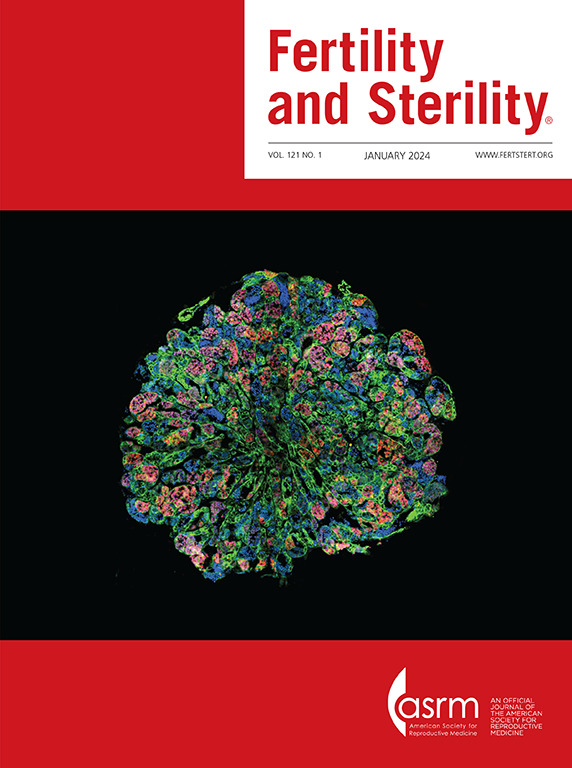胶原支架与宫内节育器对预防宫内粘连复发的影响:一项多中心随机对照试验。
IF 7
1区 医学
Q1 OBSTETRICS & GYNECOLOGY
引用次数: 0
摘要
目的评价胶原支架与宫内节育器(IUD)预防宫腔镜下中度宫内粘连(IUA)术后粘连复发的疗效。设计一项多中心、开放标签、随机对照、双组优势临床试验。2023年2月至2024年9月,六所三级大学附属医院。受试者年龄20-40岁,伴有中度iua(根据美国生育学会[AFS]评分5-8分),计划接受宫腔镜粘连松解术。手术后随机分为胶原支架组和宫内节育器组(1:1),分别接受激素治疗。粘连松解术后2个月行二次宫腔镜检查(SLH)。主要结局:主要结局为SLH患者IUA无复发率。次要结果包括SLH时AFS评分,SLH时AFS评分下降,术后1个月和2个月月经状况改善。结果195例患者随机分为胶原支架组(n = 98)和宫内节育器组(n = 97)。胶原支架组SLH无IUA复发率明显高于IUD组(78.6% vs. 58.8%;危险比为1.4;95%可信区间为1.1 ~ 1.6;P=0.003)。两组患者的AFS评分及SLH时AFS评分的下降无显著差异。两组不良事件发生率无差异,未见严重不良事件的报道。结论胶原支架在预防宫腔镜下宫内节育器术后粘连复发方面优于宫内节育器。本文章由计算机程序翻译,如有差异,请以英文原文为准。
Effect of collagen scaffold versus intrauterine device on preventing recurrence of intrauterine adhesions: a multicenter randomized controlled trial.
OBJECTIVE
To evaluate the efficacy of collagen scaffold versus intrauterine device (IUD) in prevention of adhesion recurrence in moderate intrauterine adhesions (IUA) following hysteroscopic adhesiolysis.
DESIGN
A multicenter, open-label, randomized controlled, two-arm superiority clinical trial.
SETTING
Six tertiary university hospitals from February 2023 to September 2024.
SUBJECTS
Participants aged 20-40 years with moderate IUAs (based on American Fertility Society [AFS] score 5-8) planned to accept hysteroscopic adhesiolysis.
INTERVENTION
Participants were randomly allocated to collagen scaffold group or IUD group (1:1) and received hormonal therapy after surgery. A second-look hysteroscopy (SLH) was scheduled at 2 months after the adhesiolysis.
MAIN OUTCOME
The primary outcome was the rate of no IUA recurrence at SLH. The secondary outcomes included AFS score at SLH, decrease of AFS score at SLH, and menstrual pattern improvement at 1-month and 2-month post-operation.
RESULTS
A total of 195 patients were randomized to collagen scaffold group (n = 98) or IUD group (n = 97). The rate of no IUA recurrence at SLH in collagen scaffold group was significantly higher than that in IUD group (78.6% vs. 58.8%; risk ratio, 1.4; 95% confidence interval, 1.1-1.6; P=0.003). There was no significant difference in AFS score and decrease of AFS score at SLH between the two groups. The incidence of adverse events did not differ between the two groups and no serious adverse events were reported.
CONCLUSION
Collagen scaffold is superior to IUD in preventing adhesion recurrence after hysteroscopic adhesiolysis in moderate IUAs.
求助全文
通过发布文献求助,成功后即可免费获取论文全文。
去求助
来源期刊

Fertility and sterility
医学-妇产科学
CiteScore
11.30
自引率
6.00%
发文量
1446
审稿时长
31 days
期刊介绍:
Fertility and Sterility® is an international journal for obstetricians, gynecologists, reproductive endocrinologists, urologists, basic scientists and others who treat and investigate problems of infertility and human reproductive disorders. The journal publishes juried original scientific articles in clinical and laboratory research relevant to reproductive endocrinology, urology, andrology, physiology, immunology, genetics, contraception, and menopause. Fertility and Sterility® encourages and supports meaningful basic and clinical research, and facilitates and promotes excellence in professional education, in the field of reproductive medicine.
 求助内容:
求助内容: 应助结果提醒方式:
应助结果提醒方式:


